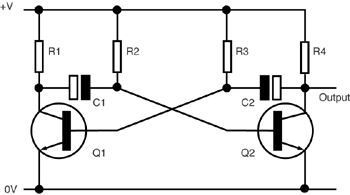Multivibrator
|
|
A multivibrator is an electronic circuit used to implement a variety of simple two-state systems such as oscillators, timers and flip-flops. The most common form is the astable or oscillating type, which generates a square wave - the high level of harmonics in its output is what gives the multivibrator its common name.
There are three types of multivibrator circuit:
- astable, in which the circuit is not stable in either state - it continuously oscillates from one state to the other. Another name for this type of circuit is relaxation oscillator.
- monostable, in which one of the states is stable, but the other is not - the circuit will flip into the unstable state for a determined period, but will eventually return to the stable state. Such a circuit is useful for creating a timing period of fixed duration in response to some external event.
- bistable, in which the circuit will remain in either state indefinitely. The circuit can be flipped from one state to the other by an external event or trigger. Such a circuit is important as the fundamental building block of a register or memory device.
In its simplest form the multivibrator circuit consists of two cross-coupled transistors. Using resistor-capacitor networks within the circuit to define the time periods of the unstable states, the various types may be implemented. Multivibrators find applications in a variety of systems where square waves or timed intervals are required, but the simple circuits tend to be fairly inaccurate, so are rarely used where precision is required. An integrated circuit multivibrator, the 555, is very common in electronics. It uses a more sophisticated design to overcome some of the precision issues with the simpler circuits.
Astable Multivibrator circuit
This circuit shows a typical simple astable circuit. It works as follows: Consider that Q1 is turned on and conducting. The voltage on its collector will be close to zero, causing C1 to charge via R2. When the voltage on C1 reaches 0.6V, Q2 will switch on, dropping the output level to 0V. C2 will discharge, switching off Q1. C2 is now charged via R3 until it reaches 0.6V, at which point Q1 will switch on again, discharging C1 and switching off Q2. The output goes high again and the cycle will repeat indefinitely. The ratios of R2/C1 and R3/C2 give the on and off times of each transistor - they do not have to be equal time constants, the output can therefore be made to have any duty cycle desired.
External links
- Java applet (http://www.falstad.com/circuit/ex-multivib.html) simulates the above circuit.de:Multivibrator

